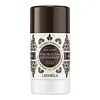What's inside
What's inside
 Key Ingredients
Key Ingredients

 Benefits
Benefits

 Concerns
Concerns

 Ingredients Side-by-side
Ingredients Side-by-side

Aloe Barbadensis Leaf Juice
Skin ConditioningPropanediol
SolventZea Mays Starch
AbsorbentSodium Stearate
CleansingSilica
AbrasiveCarrageenan
Stearyl Behenate
EmollientCitrus Medica Peel Oil
Inulin
Skin ConditioningSaccharomyces Ferment
Skin ConditioningAlpha-Glucan Oligosaccharide
CleansingYeast Beta-Glucan
Skin ConditioningLonicera Caprifolium Flower Extract
PerfumingUsnea Barbata Extract
Valeriana Officinalis Root Extract
Skin ConditioningHydrastis Canadensis Extract
MaskingMelaleuca Alternifolia Flower/Leaf/Stem Extract
Skin ConditioningLycium Barbarum Fruit Extract
AstringentVanilla Planifolia Fruit Oil
EmollientParfum
MaskingAloe Barbadensis Leaf Juice, Propanediol, Zea Mays Starch, Sodium Stearate, Silica, Carrageenan, Stearyl Behenate, Citrus Medica Peel Oil, Inulin, Saccharomyces Ferment, Alpha-Glucan Oligosaccharide, Yeast Beta-Glucan, Lonicera Caprifolium Flower Extract, Usnea Barbata Extract, Valeriana Officinalis Root Extract, Hydrastis Canadensis Extract, Melaleuca Alternifolia Flower/Leaf/Stem Extract, Lycium Barbarum Fruit Extract, Vanilla Planifolia Fruit Oil, Parfum
Neopentyl Glycol Diheptanoate
EmollientPPG-15 Stearyl Ether
EmollientZea Mays Starch
AbsorbentOzokerite
Emulsion StabilisingStearyl Alcohol
EmollientIsododecane
EmollientIsopentyldiol
HumectantMaranta Arundinacea Root Powder
Skin ConditioningLauryl Laurate
Skin ConditioningMandelic Acid
AntimicrobialSorbitan Oleate
EmulsifyingParfum
MaskingSilica
AbrasivePanthenol
Skin ConditioningCaffeine
Skin ConditioningEthylhexylglycerin
Skin Conditioning
 Reviews
Reviews

Ingredients Explained
These ingredients are found in both products.
Ingredients higher up in an ingredient list are typically present in a larger amount.
Parfum is a catch-all term for an ingredient or more that is used to give a scent to products.
Also called "fragrance", this ingredient can be a blend of hundreds of chemicals or plant oils. This means every product with "fragrance" or "parfum" in the ingredients list is a different mixture.
For instance, Habanolide is a proprietary trade name for a specific aroma chemical. When used as a fragrance ingredient in cosmetics, most aroma chemicals fall under the broad labeling category of “FRAGRANCE” or “PARFUM” according to EU and US regulations.
The term 'parfum' or 'fragrance' is not regulated in many countries. In many cases, it is up to the brand to define this term.
For instance, many brands choose to label themselves as "fragrance-free" because they are not using synthetic fragrances. However, their products may still contain ingredients such as essential oils that are considered a fragrance by INCI standards.
One example is Calendula flower extract. Calendula is an essential oil that still imparts a scent or 'fragrance'.
Depending on the blend, the ingredients in the mixture can cause allergies and sensitivities on the skin. Some ingredients that are known EU allergens include linalool and citronellol.
Parfum can also be used to mask or cover an unpleasant scent.
The bottom line is: not all fragrances/parfum/ingredients are created equally. If you are worried about fragrances, we recommend taking a closer look at an ingredient. And of course, we always recommend speaking with a professional.
Learn more about ParfumSilica, also known as silicon dioxide, is a naturally occurring mineral. It is used as a fine, spherical, and porous powder in cosmetics.
Though it has exfoliant properties, the function of silica varies depending on the product.
The unique structure of silica enhances the spreadability and adds smoothness, making it a great texture enhancer.
It is also used as an active carrier, emulsifier, and mattifier due to its ability to absorb excess oil.
In some products, tiny microneedles called spicules are made from silica or hydrolyzed sponge. When you rub them in, they lightly polish away dead skin layers and enhance the penetration of active ingredients.
Learn more about SilicaZea Mays Starch is starch made from corn. You might know this as cornstarch . It is used to thicken a product. It can replace talc as an absorbent.
The pH of cornstarch is 5.92.
Cornstarch is a common food ingredient used to thicken soups or to make corn syrup.
Learn more about Zea Mays Starch